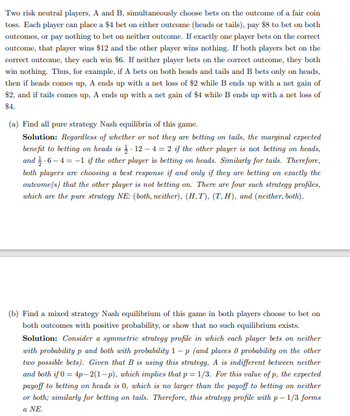
ENGR.ECONOMIC ANALYSIS
14th Edition
ISBN: 9780190931919
Author: NEWNAN
Publisher: Oxford University Press
expand_more
expand_more
format_list_bulleted
Question
PLEASE CHECK THIS HOW TO SOLVE

Transcribed Image Text:Two risk neutral players, A and B, simultaneously choose bets on the outcome of a fair coin
toss. Each player can place a $4 bet on either outcome (heads or tails), pay $8 to bet on both
outcomes, or pay nothing to bet on neither outcome. If exactly one player bets on the correct
outcome, that player wins $12 and the other player wins nothing. If both players bet on the
correct outcome, they each win $6. If neither player bets on the correct outcome, they both
win nothing. Thus, for example, if A bets on both heads and tails and B bets only on heads,
then if heads comes up, A ends up with a net loss of $2 while B ends up with a net gain of
$2, and if tails comes up, A ends up with a net gain of $4 while B ends up with a net loss of
$4.
(a) Find all pure strategy Nash equilibria of this game.
Solution: Regardless of whether or not they are betting on tails, the marginal expected
benefit to betting on heads is 12-4 = 2 if the other player is not betting on heads,
and-6-4-1 if the other player is betting on heads. Similarly for tails. Therefore,
both players are choosing a best response if and only if they are betting on exactly the
outcome(s) that the other player is not betting on. There are four such strategy profiles,
which are the pure strategy NE: (both, neither), (H,T), (T, H), and (neither, both).
(b) Find a mixed strategy Nash equilibrium of this game in both players choose to bet on
both outcomes with positive probability, or show that no such equilibrium exists.
Solution: Consider a symmetric strategy profile in which each player bets on neither
with probability p and both with probability 1-p (and places 0 probability on the other
two possible bets). Given that B is using this strategy, A is indifferent between neither
and both if 0 = 4p-2(1-p), which implies that p = 1/3. For this value of p, the expected
payoff to betting on heads is 0, which is no larger than the payoff to betting on neither
or both; similarly for betting on tails. Therefore, this strategy profile with p-1/3 forms
a NE.
Expert Solution
This question has been solved!
Explore an expertly crafted, step-by-step solution for a thorough understanding of key concepts.
Step by stepSolved in 3 steps

Knowledge Booster
Learn more about
Need a deep-dive on the concept behind this application? Look no further. Learn more about this topic, economics and related others by exploring similar questions and additional content below.Similar questions
arrow_back_ios
arrow_forward_ios
Recommended textbooks for you

 Principles of Economics (12th Edition)EconomicsISBN:9780134078779Author:Karl E. Case, Ray C. Fair, Sharon E. OsterPublisher:PEARSON
Principles of Economics (12th Edition)EconomicsISBN:9780134078779Author:Karl E. Case, Ray C. Fair, Sharon E. OsterPublisher:PEARSON Engineering Economy (17th Edition)EconomicsISBN:9780134870069Author:William G. Sullivan, Elin M. Wicks, C. Patrick KoellingPublisher:PEARSON
Engineering Economy (17th Edition)EconomicsISBN:9780134870069Author:William G. Sullivan, Elin M. Wicks, C. Patrick KoellingPublisher:PEARSON Principles of Economics (MindTap Course List)EconomicsISBN:9781305585126Author:N. Gregory MankiwPublisher:Cengage Learning
Principles of Economics (MindTap Course List)EconomicsISBN:9781305585126Author:N. Gregory MankiwPublisher:Cengage Learning Managerial Economics: A Problem Solving ApproachEconomicsISBN:9781337106665Author:Luke M. Froeb, Brian T. McCann, Michael R. Ward, Mike ShorPublisher:Cengage Learning
Managerial Economics: A Problem Solving ApproachEconomicsISBN:9781337106665Author:Luke M. Froeb, Brian T. McCann, Michael R. Ward, Mike ShorPublisher:Cengage Learning Managerial Economics & Business Strategy (Mcgraw-...EconomicsISBN:9781259290619Author:Michael Baye, Jeff PrincePublisher:McGraw-Hill Education
Managerial Economics & Business Strategy (Mcgraw-...EconomicsISBN:9781259290619Author:Michael Baye, Jeff PrincePublisher:McGraw-Hill Education


Principles of Economics (12th Edition)
Economics
ISBN:9780134078779
Author:Karl E. Case, Ray C. Fair, Sharon E. Oster
Publisher:PEARSON

Engineering Economy (17th Edition)
Economics
ISBN:9780134870069
Author:William G. Sullivan, Elin M. Wicks, C. Patrick Koelling
Publisher:PEARSON

Principles of Economics (MindTap Course List)
Economics
ISBN:9781305585126
Author:N. Gregory Mankiw
Publisher:Cengage Learning

Managerial Economics: A Problem Solving Approach
Economics
ISBN:9781337106665
Author:Luke M. Froeb, Brian T. McCann, Michael R. Ward, Mike Shor
Publisher:Cengage Learning

Managerial Economics & Business Strategy (Mcgraw-...
Economics
ISBN:9781259290619
Author:Michael Baye, Jeff Prince
Publisher:McGraw-Hill Education